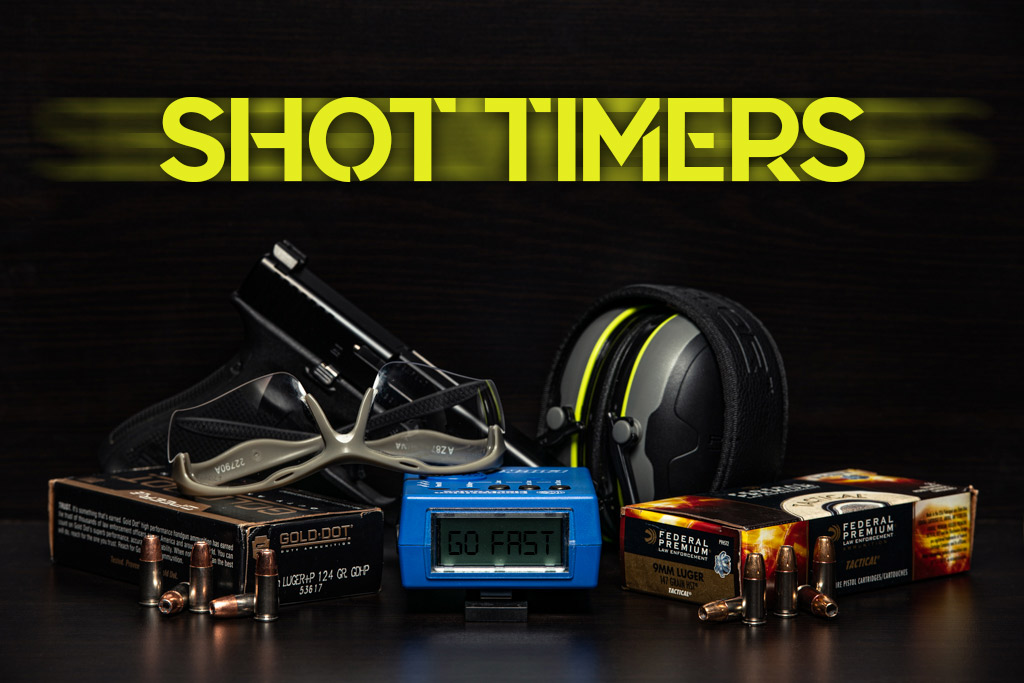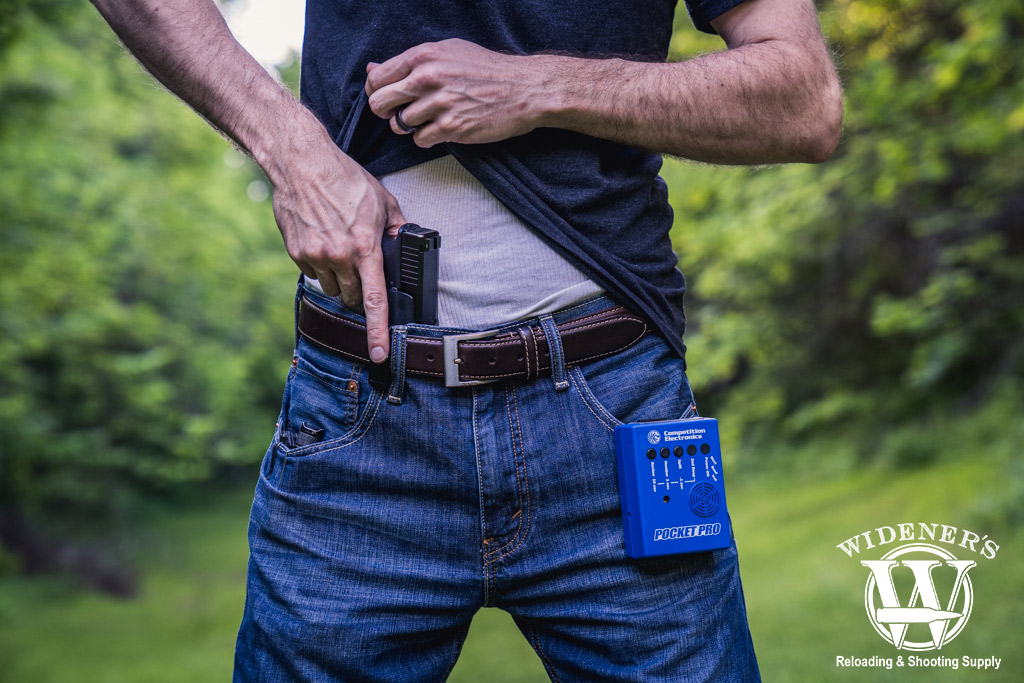

By Guy J. Sagi
A basic shot timer measures and records how long it takes to deliver shots—or audibly signal when shooting can begin and must end. The versatile tool offers much more than a yardstick for competitive shooters or SWAT teams, though. The applications are ideal for gun owners with concealed carry permits and they breathe new life into informal range sessions.
A Measurement Of Time
There is no denying the shot timer’s roots grew in competitive shooting, though. Stopwatches were the early scoring approach during matches, although accuracy hinged on the timepiece operator’s reactions and consistency through often lengthy events. Results were sometimes dubious.
An early remedy was moving time measurement downrange to minimize human error, when a stopwatch rigged to the final steel target stopped when a bullet struck the metal—the stop plate. It could also signal when time was up, allowing total hits on targets in that stage to serve as the score. It was an innovative solution, one still used to this day. Early versions didn’t offer the hundredths-of-a-second accuracy that typically separates top shooters, though.
Electronics Debut
The first glimpse of the future came in 1924, when a contraption attached to Ed McGivern’s double-action revolver measured and confirmed his blazing speed. He delivered six accurate shots on target at a scalding 0.8 seconds.
The cutting-edge technology was accurate and made headlines, but it wasn’t available to enthusiasts and few competitive shooting circuits could afford it. Gear on a firearm wasn’t mainstream at the time, either.
Six decades later, in 1981, to be more precise, Bill Rogers invented a timer with an audible beep that signaled shooting could begin. A second beep followed to indicate the session had ended—so-called par timing. The period between the audible markers could be varied, making it effortless for match directors to increase a stage’s difficulty.
Other innovations followed from different sources, including a microphone to detect the precise moment of each shot, hardware to report the findings and ability to connect to a stop plate. Now the displays are easier to read, their microprocessors instantly perform calculations, sensitivity can be varied for use on busy ranges, and more. They also became more reliable, smaller, easier to operate and downright affordable. Smartphone Apps are even available.
Modern Shot Timers

An electronic shot timer is an excellent investment for anyone wanting to improve their shooting skills.
Today’s versions include the option of par timing, but most also audibly signal the “start” to a session and a sensor (usually a microphone) detects the shots that follow. It stores the information internally for review. A split-time function displays the period between each round.
It’s solid information for competitive shooters, but equally applicable for self-defense enthusiasts. The time required to get back on target and deliver a second accurate shot reflects the shooter’s ability to handle recoil. One-shot stops are common on the silver screen, but in real life criminal attackers often need to be re-engaged.
Portable, Solo Use
We’re all familiar with cameras that have a timer in which you press the button and it counts down before the shutter releases—allowing the photographer time to get in the photo. Some shot timers have a similar feature. It allows enthusiasts to perform timed drills and measure skills unaided. When set to that function, press the button and you have time to make ready. On some units that delay can be varied or random.
Most of today’s versions weigh mere ounces and are handheld or ride on a belt. Versions with variable sensitivity are ideal for cramped ranges and modern versions run on inexpensive and easy-to-find batteries. Good shot timers power down after a period of inactivity to ensure the power supply’s longevity, too.
They may provide accurate scores in competition, but it didn’t take long for self-defense instructors to recognize a shot timer’s ability to increase pressure on students during live-fire range sessions. Those with carry permits should consider purchasing one, and even recreational shooters looking to add spice to those range sessions.
There’s no limit to the uses of today’s shot timers. New drills surface daily, but enthusiasts must always obey the rules of gun safety and not concentrate on going fast, at least at first. Start slow, with proper technique to build muscle memory. Done often enough—safely and properly—speed will arrive. Quality training courses remind students “smooth is fast.” It’s good advice. For obvious reasons, conduct dry-fire drills with an unloaded gun, empty magazine and cartridges far away, preferably in another room. Keep a notebook to monitor your progress.
Shot Timer Drills

A quick way to improve your draw stroke is to practice drawing from a holster while using a shot timer.
Here are a few shot timer drills to start you off.
Par Time, Live Fire
Once the buzzer sounds, present the gun and deliver as many accurate shots as you can before the par time’s second buzzer sounds. If you empty the magazine, without missing, it’s time to reduce allotted time or increase distance.
Do the same, but start with an unloaded gun and empty magazine. At the buzzer drop the unloaded mag, insert one fully loaded, chamber a round and hit the target as many times as possible before time is up.
With a round in the chamber and a single cartridge in the magazine, engage the target at the buzzer. Continue firing and change the magazine when needed.
Add movement (when allowed), multiple targets or a requirement to hit different parts of the target. Invent your own challenges—always with safety in mind—and there’s no limit to the fun.
Comstock, Live Fire
Many call the function that provides the exact moment of each shot Comstock mode, and it’s ideal for precise measurement in all the above drills. It also provides the split times required to determine if a shooter is back on target efficiently and reload speed.
Keep notes to monitor progress and don’t forget to clear the memory. Today’s shot timers often record strings of 50 or more rounds.
Par, Dry Fire
When dry fire practicing—with an unloaded gun and magazine with cartridges separated—there is no sound loud enough for shot timer detection. Par timing doesn’t require one, however, and can be an invaluable training tool from the comfort of home.
Place a paper target on the wall, select a time you think you beat and hit the start button. If you can get the sight picture and squeeze what would have been a good shot before the second buzzer, reduce the time. Continue to do so, remembering you’re committing a “smooth is fast” motion to muscle memory.
Start from unconventional positions, like sitting, laying down, or facing a different direction. Can you reach the cover of a wall, engage and still beat the clock? That’s critical for home defense.
Shot Timer Dry Fire Practice

From competition to home defense, dry fire practice with a shot timer improves speed and performance under pressure.
If you have a concealed carry permit, dry firing with a shot timer is the ideal way to practice. It’s a safe way to learn your cover garment draw and practice delivering a fight-stopping shot. The moves are more cumbersome than you think. If range rules allow drawing from a holster, and once you’ve practiced enough, consider this one for live fire. In both cases, remember smooth and safe is key and watch your support hand movement and placement. And never re-holster fast.
Today, more than ever, there are a variety of good reasons enthusiasts should have a shot timer in their range bag. Practice makes perfect, and a shot timer will help you get there faster, regardless of your firing-line pursuits.


